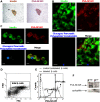Exploring functional beta-cell heterogeneity in vivo using PSA-NCAM as a specific marker
- PMID: 19440374
- PMCID: PMC2679208
- DOI: 10.1371/journal.pone.0005555
Exploring functional beta-cell heterogeneity in vivo using PSA-NCAM as a specific marker
Abstract
Background: The mass of pancreatic beta-cells varies according to increases in insulin demand. It is hypothesized that functionally heterogeneous beta-cell subpopulations take part in this process. Here we characterized two functionally distinct groups of beta-cells and investigated their physiological relevance in increased insulin demand conditions in rats.
Methods: Two rat beta-cell populations were sorted by FACS according to their PSA-NCAM surface expression, i.e. beta(high) and beta(low)-cells. Insulin release, Ca(2+) movements, ATP and cAMP contents in response to various secretagogues were analyzed. Gene expression profiles and exocytosis machinery were also investigated. In a second part, beta(high) and beta(low)-cell distribution and functionality were investigated in animal models with decreased or increased beta-cell function: the Zucker Diabetic Fatty rat and the 48 h glucose-infused rat.
Results: We show that beta-cells are heterogeneous for PSA-NCAM in rat pancreas. Unlike beta(low)-cells, beta(high)-cells express functional beta-cell markers and are highly responsive to various insulin secretagogues. Whereas beta(low)-cells represent the main population in diabetic pancreas, an increase in beta(high)-cells is associated with gain of function that follows sustained glucose overload.
Conclusion: Our data show that a functional heterogeneity of beta-cells, assessed by PSA-NCAM surface expression, exists in vivo. These findings pinpoint new target populations involved in endocrine pancreas plasticity and in beta-cell defects in type 2 diabetes.
Conflict of interest statement
Figures







References
-
- Ahrén B, Thorsson O. Increased insulin sensitivity is associated with reduced insulin and glucagon secretion and increased insulin clearance in man. J Clin Endocrinol Metab. 2003;88:1264–1270. - PubMed
-
- Parsons JA, Brelje TC, Sorenson RL. Adaptation of islets of Langerhans to pregnancy: increased islet cell proliferation and insulin secretion correlates with the onset of placental lactogen secretion. Endocrinology. 1992;130:1459–1466. - PubMed
-
- Klöppel G, Löhr M, Habich K, Oberholzer M, Heitz PU. Islet pathology and the pathogenesis of type 1 and type 2 diabetes mellitus revisited. Surv Synth Pathol Res. 1985;4:110–125. - PubMed
-
- Van Schravendijk CF, Kiekens R, Pipeleers DG. Pancreatic beta cell heterogeneity in glucose-induced insulin secretion. J Biol Chem. 1992;267:21344–21348. - PubMed
Publication types
MeSH terms
Substances
LinkOut - more resources
Full Text Sources
Other Literature Sources
Molecular Biology Databases
Research Materials
Miscellaneous

